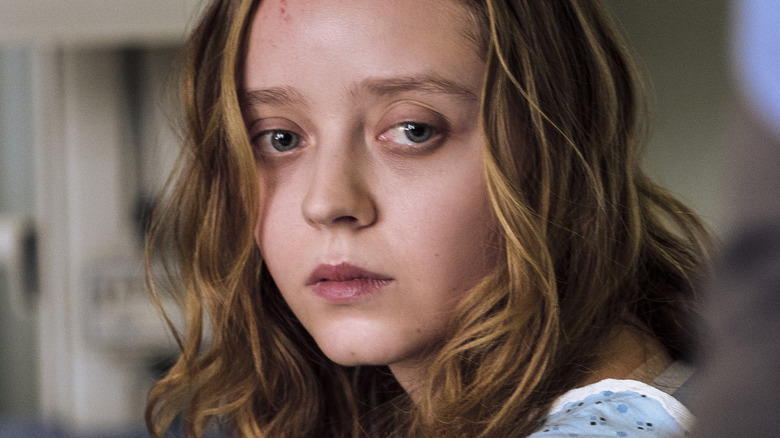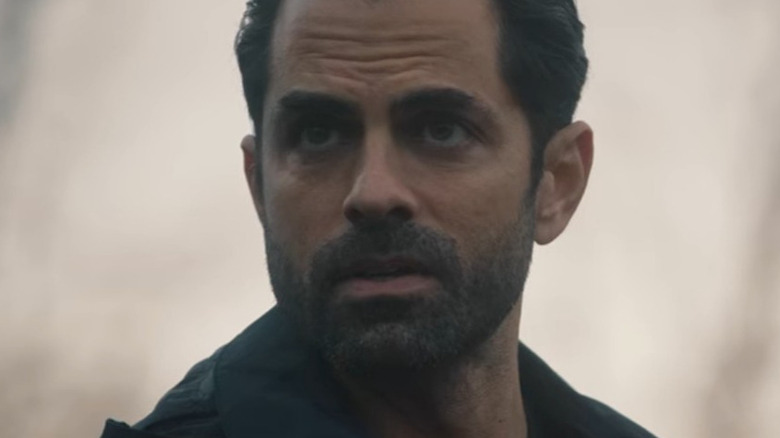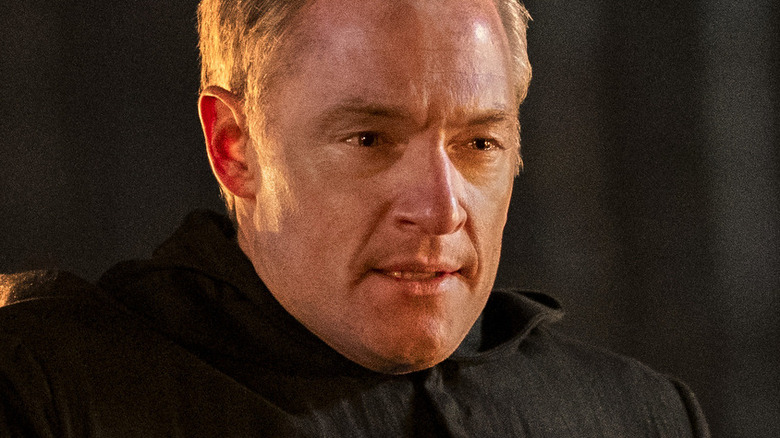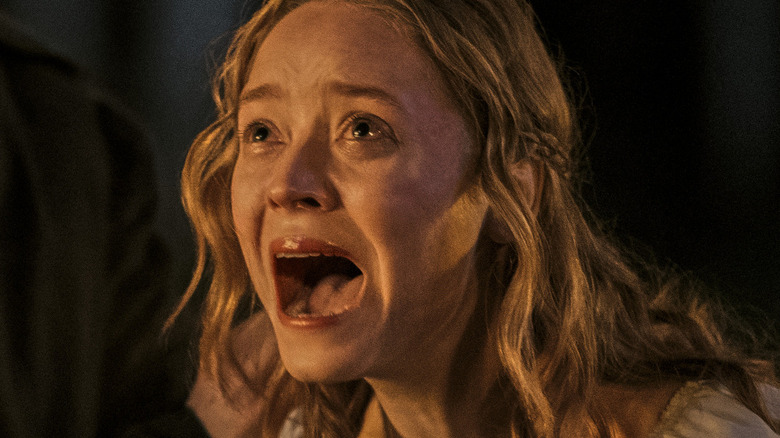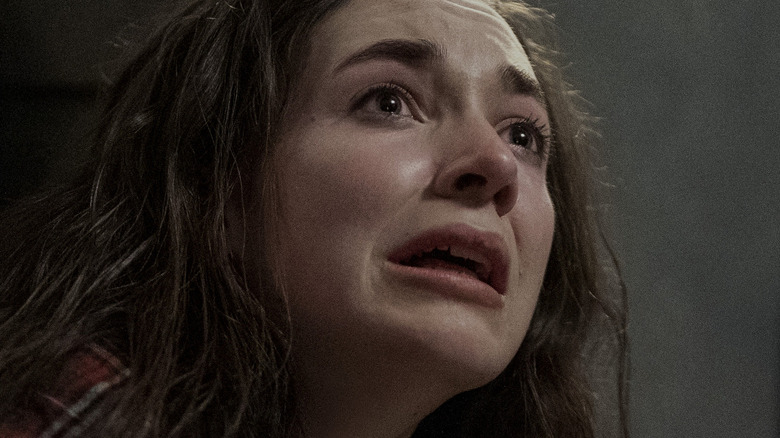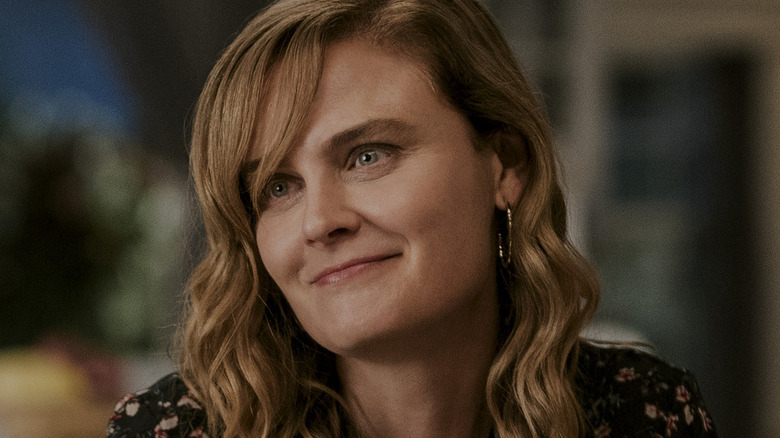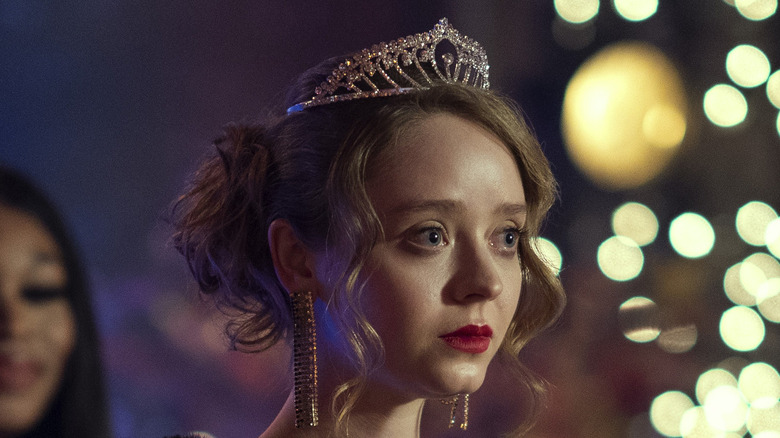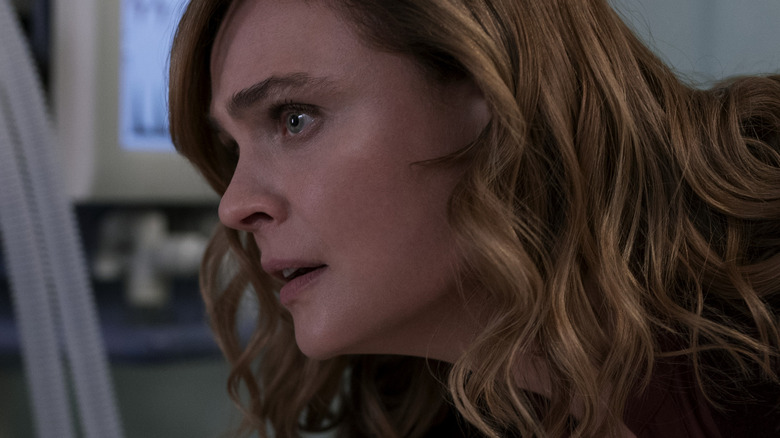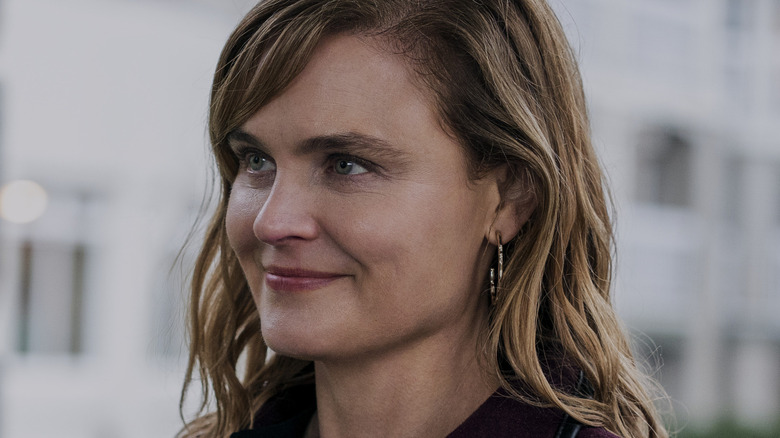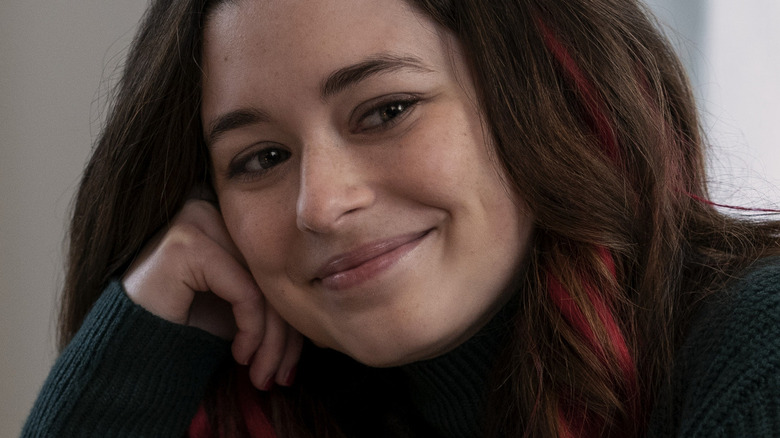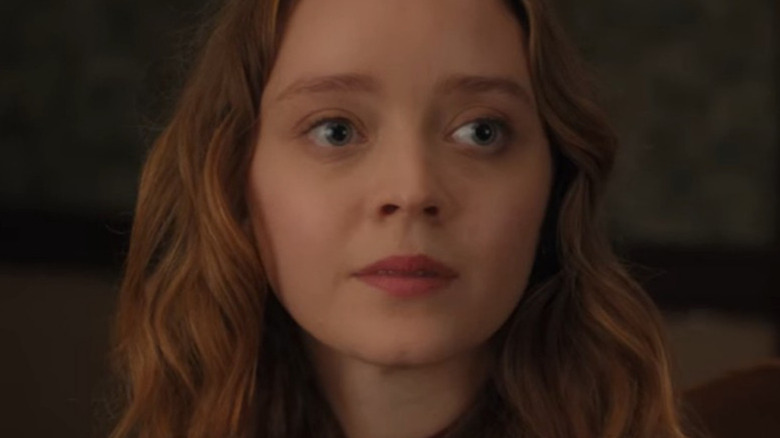The Ending Of Devil In Ohio Explained
Horror show "Devil in Ohio" follows Dr. Suzanne Mathis (Emily Deschanel) as she tries to help Mae (Madeleine Arthur), a teen who runs away from a cult to save her life. But as Mae integrates herself into Suzanne's life, weird occurrences begin to happen that negatively impact the Mathis family and start to drive a wedge between Suzanne and her husband Peter (Sam Jaeger).
Over the course of the series, Suzanne deals with resurfacing trauma in her own life while Mae struggles to completely break free from the influence the cult and her family have over her. The teen's presence impacts everyone, including the three Mathis children, in different ways — some better and some worse. Members of the cult approach the family in a variety of settings, from trying to date (and potentially kidnap) one of the Mathis daughters to burning down the property Peter has spent thousands of dollars building and is hoping to sell. They'll go to extreme lengths to force Mae to come back to the cult, so that they can complete the ritual she was chosen for.
As "Devil in Ohio" comes to a close, all these vivid issues and tensions come to a head, forcing each character to make a decision that could impact their life in a substantial way. We're here to break down this complex ending, from where everyone ends up to what a major reveal could mean for the characters' futures and their positions in the family.
The cult leaves town
After everything Detective Lopez (Gerardo Celasco) discovers about Amontown, he's determined to search the property and find out what else they're hiding behind closed chapel doors. Following the events of the sacrifice and the revelation that much of the sheriff's department was under the cult's thumb, Lopez is promoted to lieutenant. It takes some time, but eventually, a judge grants him a search warrant for the cult's compound. But it's too late: When Lopez arrives with the warrant, the cult has cleared out, with only Sheriff Wilkins' (Bradley Stryker) dog left behind.
What does this mean for the future of the cult? For one thing, the cult no longer has the safeguards that were previously in place for them. With Wilkins' death, many other officers decide to step down — an act implied to be their way of going out on their own terms, rather than getting fired for their involvement with the cult. This means the group needs a new place to go, to operate under the radar. Without a sheriff's department looking the other way, there's a much greater chance that they'll end up in serious legal trouble.
Amontown has been operating in the area for several decades, based on Suzanne's communication with college professor Dr. Hawkins (Lossen Chambers). "For a century, they've been isolated," the professor says in Episode 4, "Rely-upon." "Very little is known about this community." This gives the impression they've been there for quite some time. Moving away from their longtime home is likely to be a difficult decision.
Leaving some loose ends behind
Despite deserting the area, the people of Amontown leave behind some people who know about them. Suzanne has been researching the cult, Detective Lopez has learned about their practices, and, of course, Mae is intimately informed of the cult's beliefs and practices. While they have no legal protection in the area anymore, there are still people who know about them — and can come after them.
While we can't know what their leader and Mae's father, Malachi (Tahmoh Penikett), is thinking when he decides to move the cult, he may not be worried about the people who know about their practices. He's probably writing off his daughter as a lost cause, especially because the purpose she was meant to serve is carried out by someone else. Audiences spend the entire series watching the cult do anything they can, even burning down a house, to force Mae to come back. With them no longer in the area, Mae is free to live the life that she wants to. There's simply no reason for her to be concerned about the cult anymore.
They also leave behind a lieutenant who knows what they're capable of, but will likely have no jurisdiction over them, in Detective Lopez. Even if Lopez did somehow have the necessary jurisdiction, the cult could get to the local authorities first. This means that loose ends just don't merit much concern on the cult's part — they know that they still have the upper hand.
By blood we are still broken
The final episode of "Devil in Ohio," "The Dawning," shows that despite Mae refusing to participate in the sacred ritual, the ritual still goes on. Rather than Mae being sacrificed to help sustain the cult, her mother Abigail (Caroline Cave) takes her place. In doing this, the chain remains unbroken, since she is a willing participant. However, that doesn't stop her husband Malachi from initially being shocked at his wife's actions. He recovers quickly, and puts the event in a positive light for his followers. But this quick spin doesn't overwrite the fact that in the moment, he is losing both his daughter and his wife.
Throughout the series, the phrase "by blood we are broken" is repeatedly used to show that the cult is only as strong as the familial ties within it. Abigail taking Mae's place in the sacrifice shows the lengths the cult is willing to go to maintain that mantra. This action also upholds their second maxim: "The chain shall not be broken." Abigail's sacrifice protects the cult, but it also means that Mae is literally losing her mother — and not just figuratively, as she does when initially leaving the cult.
Watching her mother die adds to the trauma Mae has experienced at the hands of the cult. Her blood-curdling screams for her mother are one of the most disturbing moments in "Devil in Ohio," and reinforce that the cult will only continue to negatively impact the teen if it remains a part of her life.
Suzanne is rewriting her own story
Throughout "Devil in Ohio," audiences are shown flashbacks to Suzanne's childhood. It wasn't a great one, with a checked-out mother who was also experiencing abuse and a stepfather who utilized dangerous forms of punishment if he didn't like how the teen behaved. Her experiences resulted in her running away, leaving her mother and stepfather behind as she went to live with her grandmother.
Suzanne sees herself in Mae, even if she doesn't realize this at first. Like the matriarch, the teen runs away from a cult to prevent her father from continuing to inflict harm on her, which her mother doesn't protect her from. Though the psychiatrist doesn't recognize that she sees herself in Mae until she starts therapy, she is ultimately trying to rewrite her childhood by helping Mae get away from the cult. There was no one to help Suzanne: She had to make her escape attempt alone. While Mae initially escapes by herself, Suzanne helps her break free for a second time the night of the school dance, risking her life to sneak into Amontown and bring Mae back home.
This is a formative experience for Suzanne. Giving another teenage girl the help she desperately wanted at that age almost helps her rewrite history, and helps her gain new insight into herself.
Looking in the mirror
Suzanne and Mae's experiences are in parallel, though the psychiatrist is able to change history for her foster daughter. This experience helps Suzanne realize that she's never come to terms with what happened to her during her childhood and how it's impacting her life in the present.
"There was a part of myself that I kept hidden," Suzanne says during a therapy appointment in "The Dawning." "I was afraid to admit that things were more complicated." She recognizes that the ordeals she's experienced, including what Mae has put her and her family through, have opened her eyes to the buffers she had in place that prevented her from dealing with her pain. Said buffers include staying busy at work, doing things with her family, and other decisions she's made in her life over the years.
She notes it's hard to come to terms with who she is as a person and how that's been influenced by the events of her childhood. She also recognizes that she projected her teenage want to be saved onto Mae. This realization allows her to start work towards connecting the two parts of herself: the one filled with pain and the front she's put up. Suzanne is also hopeful that Mae can put in the same work that she's currently undertaking. But after what's revealed, that may not be in the cards for the runaway teen.
Mae's true nature is revealed
While Mae comes across as aloof and socially naïve due to her unique upbringing, it's revealed in "The Dawning" that she has a significant amount of control over the things that happened to her. Mae confirms earlier on that she swapped out the photos for the school newspaper feature about her, choosing to insert a picture of her scar rather than the one Jules (Xaria Dotson) selected. In this instance, her behavior comes across as an innocent act for Jules' benefit as a photographer. But the nature of this choice changes with the final reveal of the series.
Detective Lopez informs Suzanne that Mae is responsible for her own triggering just as she and the teen are about to eat Thanksgiving dinner. Camera footage shows that the teen swapped out the original flowers for the Harvest Queen with white roses, which audiences know previously trigged Mae to return to the cult. But this time they don't actually trigger her — she fakes it. Mae proceeds to steal a car and drive to Amontown, all in a presumed effort to force Suzanne to save her.
This is where the similarities between the teen and the psychiatrist end. Suzanne has never manipulated the people in her life to be with her. Mae, in contrast, does everything to have Suzanne to herself. She wants to create a new family, even if it's to the detriment of Suzanne's existing family. All of Mae's actions are immediately called into question in this moment, forcing the audience to decide who the real villain of the show is and if Mae is truly as evil as she appears.
Suzanne loses everything
Mae seems to end up on top by the end of "Devil in Ohio." She has a new life, where she's popular at school. Her old family has disappeared into thin air. She even has a new mother who will do anything for her. Basically, everything is coming up Mae. But all of this positivity has created chaos for Suzanne.
Suzanne appears to lose everything by the end of the series. Her husband and children have moved out of the family home, opting to live in the apartment complex Peter manages. They want nothing to do with Mae, meaning Mae and Suzanne are celebrating the holidays by themselves. The psychiatrist isn't going to work, choosing to work on herself instead. This is great and necessary, but it might mean she doesn't have a job to go back to. Furthermore, Suzanne breaks hospital policy and HIPAA compliance when she looks into Enoch (Max Montesi), the only other person to have escaped Amontown. This is an unethical, and potentially criminal, act, done in the name of helping Mae. The hospital board may decide to terminate her employment based on these actions.
Peter seems positive about their marriage surviving the ordeal, but that can't happen while Mae is in the picture. Suzanne still sees and spends time with her children, but they won't live under the same roof as her while the runaway teen is around. There will come a point where Suzanne has to make a decision about her family, and Mae's betrayal may have made it for her.
Unmasking Suzanne's trauma
Over the course of "Devil in Ohio," Suzanne learns about herself and reexperiences the trauma of her childhood. Flashbacks to situations she was put in, including climbing a tree as a method of escape and being handcuffed to a radiator pipe, resurface as she tries to help Mae out of her own horrific situation.
As these memories appear over the course of several weeks, going to the therapy mandated by her job helps Suzanne better understand why she's kept these memories hidden and how it's impacted her adult life. This is something that affects not only Suzanne, but her family as well. Her life experiences shield her from Mae's true nature, something that Peter and their oldest daughter Helen (Alisha Newton) pick up on immediately. This blindness damages her family tremendously. Not only does the psychiatrist need to work through the decisions she's made, so do her husband and children, especially after Suzanne seems to choose Mae over her other progeny.
Since "Devil in Ohio" is a limited series, audiences won't get to see if the time Suzanne puts into working through her trauma will be worth it. It's clear she's hoping to win her family back and create a more positive relationship with them by meeting with a therapist, at least. While Peter is receptive, there's no way of knowing if this will pan out in the long run. All we know is that Suzanne's trauma is out in the open, for better and for worse.
Suzanne's daughters make it out the other side
When viewers are introduced to the Mathis family, Jules and Helen are not on good terms. They struggle to get along and often cause difficult or tense situations within the family. However, by the end of "Devil in Ohio," the two have reconciled.
Though she's been dating Teddy (Ty Wood) for several years, Helen seems to be questioning her sexuality. This isn't something she discusses with her family, choosing instead to keep it hidden as she avoids confronting the root of her unhappiness. In the final episodes, it looks like Helen has done something about it, even potentially starting a romantic relationship with her best friend, based on their interactions during and after the Harvest Dance.
Jules starts the series with a lot of insecurity. She isn't sure of her abilities as a photographer or reporter, and defaults to the judgment of those around her. But by the end of the series, she's grown into her talent, and appears more confident in her creative decisions and interactions with her peers.
Together, Helen and Jules build a healthier relationship. It seems that Jules' realization that Mae may not be as sweet as she seems allows the two to bond in the days following the Harvest Dance, especially as they come to terms with their mother's actions at Amontown. This is one of the few positive outcomes of the series.
Mae takes her power back
As a survivor of the cult, Mae is forced to rebuild her life and learn about a world she was never exposed to. She must integrate into a society she was told is despicable, and adapt to an entirely new way of living. But even though she gets away from the cult, the teachings still live within her. Like her father, she has taken on a role to manipulate those around her and create an environment she controls. She doesn't just want a say in her life — she wants a say in the life of her new family as well. Mae forces Suzanne's hand when she gets triggered and returns to the cult during the Harvest Dance, tries to play Suzanne's daughters against each other to cause further unrest, and works to ensure her school peers are sympathetic to her and her situation. Mae is never powerless: She always has the upper hand in every situation and knows the power her actions give her.
The final shot of Mae's shrine is a great allusion to how her power has grown over the course of the series, both in her own life and those of the people she surrounds herself with. What starts as a small stump has developed into a full tree, filled with photos and other artifacts. It shows just how overarching her power over Suzanne, and Suzanne's family and life, has become.
